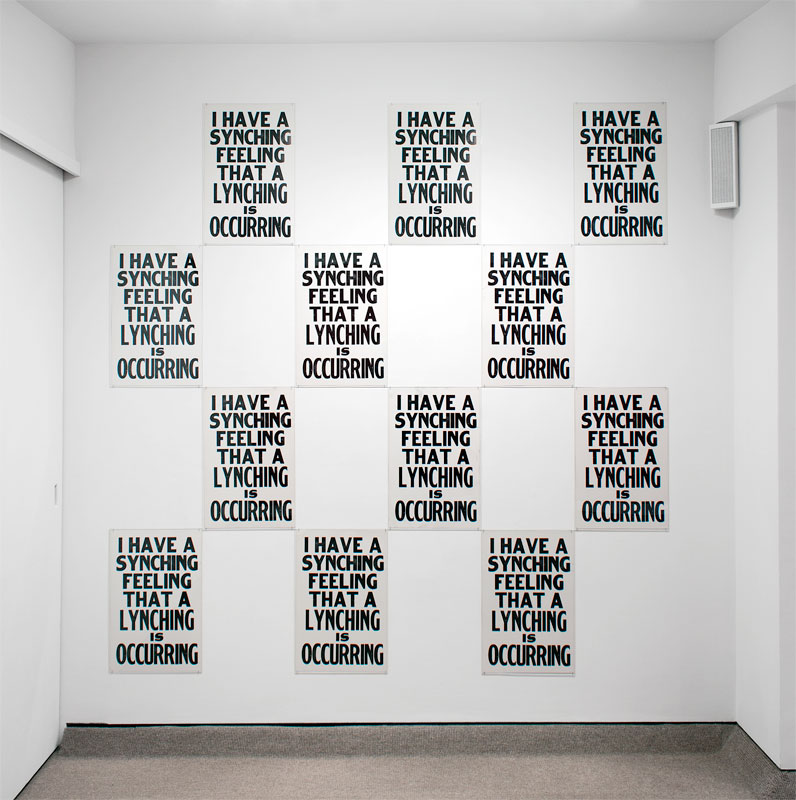
For Kay Rosen’s second exhibition at Barbara Krakow Gallery, a complete retrospective of the artists’ works with letterpress will be on display. Five, made between 1984 and 2008, along with three new works made and published (by Barbara Krakow Gallery) in a flurry of activity in the first few months of 2017, are presented using three different techniques of arranging.
The oldest work, originally conceived of in 1984, printed in 1995, consists of the text, “I HAVE A SYNCHING FEELING THAT A LYNCHING IS OCCURRING”. Presented in a checker-board arrangement covering one entire wall, Sinking Feeling draws on sound, pronunciation and meaning. It refers to ‘synching’ as a chorus of simultaneous voices, as in synchronizing; as ‘cinching,’ like a tightening noose; and of course ‘sinking.’ They combine in various ways to ‘lynching,’ a violent abduction by a mob; and ‘linking’ in which groups of people are linked and oppressed by association. To take one of these references further, the text makes bold the fearful thought that comes from a “feeling” (aka something that is not tangible). It utilizes the seemingly ‘era-appropriate’ vernacular font of the subject matter of a lynching, yet one of the key elements of the work, in this age of immediate responses and criticisms of difficult subject matter, is the absolute requirement that the work exist in multiplicity. “Officially” the work is a pair (each pair is signed and numbered as if it were one piece, which the artists considers it to be), and thus no lynching can occur without MORE THAN ONE. This rule is something that poetically refers to many troublesome issues – no one person every seems to truly act alone. In order for an awful situation to occur MULTIPLE people have to be working, in some way, together. Rosen’s work uses a play on words and verbal repetition to get at very serious topics, all while expanding the issue from one awful type of crime to the issue of human nature.
On the second wall, Rosen has painted the wall red and arranged the diptych, “Something Happened”, to be in the top right corner and the bottom left corner of the wall. The red of the wall approximates the red of the background in the diptych. The text on the top right panel reads, “CORNER”, while the bottom left panel reads, “CORONER”. As Richard Klein discusses in his essay about Rosen’s work for her current solo exhibition at the Aldrich Contemporary Museum, Rosen actively chooses the way text occupies the architecture of the page/paper. The current installation of “Something Happened” is still only a ‘representation’ of a real-life event, yet it takes the artwork a step further beyond a discrete work on paper by placing the work in a real space jointly shared by the viewer. Of course the extra “O” suggests that whatever happened wasn’t good. As both an installation and an edition, the work leaves much space in the middle both literally and figuratively.
On the third and final wall of the exhibition Rosen has arranged the newest work. “Migration” consists of two boards, one with the word, “ICELAND” printed on it while the other has “IRELAND”. The similarity of the names of the two countries, only one letter apart, presented itself as a sort of found text to Rosen, a situation that demanded to be reconstructed by color in order to make a point. It couldn’t be more relevant than it is now. While the single blue or green letter, “R” and “C” creates a little visual and semantic disruption, having “migrated” from one name/country to the other, they change the work into a more multi-hued, complex and heterogeneous ‘place’ than it was as a monochromed one.
Between the ICELAND and IRELAND elements of “Migration”, is a band of blue (perhaps the ocean between countries, perhaps a reference to the clarity of a blue sky or perhaps something else. In front of this blue band, five other letterpress works are hung, with the largest being “IOU”, the largest single print Rosen has made, to date. In Rosen’s words, “IOU” is a “found textual treasure which required minor adjustments to color to address major historical wrongs”. For anyone who has followed the attempts by the corporation, Energy Transfer Partners, to build the Dakota Access Pipeline less than one mile from the Standing Rock Sioux reservation, the message of the letterpress work “IOU” will be clear: both a promise and an apology to that tribe, and by extension, to the many other indigenous peoples whose rights and treaties have been trampled over the years. As the protocol for approval of these pipelines, such as a thorough Environmental Impact Study, is radically altered by Trump’s orders, “IOU” fashions a simple message out of the heart of the Sioux tribe’s name.
“…the critic Jerry Saltz once told me that my work has a slight autistic gene. I think he was referring to this neutral tone, to the detached third-person voice that comes from (1) minimal intervention into (2) found language, just to the point where the viewer can take over and interpret. The works are practically self-made since they are created out of their own body parts, with only a little push from me. As such, they do not filter my intentional voice or anyone’s intentional voice. They emit through the arrangement of their letters a message that is mediated and inflected by the viewer, not by me, the author. The most active gestures on my part are cognitive and physical: recognizing the language’s potential and enabling it,” excerpted from “A Constructed Conversation” (Journal #3 Vol. I/ No. 1, 2010 London; Reprinted in Social Medium: Artists Writings 2000-2015, 2016; and in Strange Oscillations and Vibrations of Sympathy, 2017)
As an historical aside, letterpress is the oldest form of printing. In this method, a surface with raised letters is inked and pressed to the surface of the printing substrate to reproduce an image in reverse. Typically, metal type has been used, but other possibilities include carved wood or stone blocks. After the Gutenberg press introduced movable type to the process in the 15th century, letterpress was the predominant printing method for approximately 500 years. The creation of huge rotary presses made industrial printing and newspaper production practical. By the 1950s, xerography and offset printing began to supplant letterpress. In the current day, digital printing and related technologies have become the industry standard for many uses. Letterpress is still used for some specialized commercial applications. The old method, with its hand-made qualities and its historical nature go hand in hand with Rosen’s subject matter all in service of commenting on the current political climate.
Since 2011, Barbara Krakow Gallery has published five works by Kay Rosen. The first two were videos: “Sisyphus” and “Blue Monday” and this exhibition highlights the most recent three (letterpress) works – “Something Happened”, “Migration”, and “IOU”. All three of the letterpress works are being exhibited for the first time and thus this exhibition also serves as the announcement of their publication. Rosen currently has exhibitions at the Aldrich Contemporary Art Museum in Ridgefield, Connecticut (running through September 4) and at Helga Maria Klosterfelde in Berlin (running through July 29). The Art Institute in Chicago has recently acquired a large wall work of hers. Recent museum exhibitions of her work have been held at Grazer Kunstverein, Graz, Austria, Contemporary Art Museum Houston, Contemporary Art Center, Cincinnati, Christchurch Art Gallery Te Puna o Waiwhetu, Christchurch, New Zealand, Museum of Fine Arts, Boston, Aspen Art Museum and in 1999 the Museum of Contemporary Art (MOCA) and Otis College of Art and Design, Los Angeles held a 25-year survey of her work.
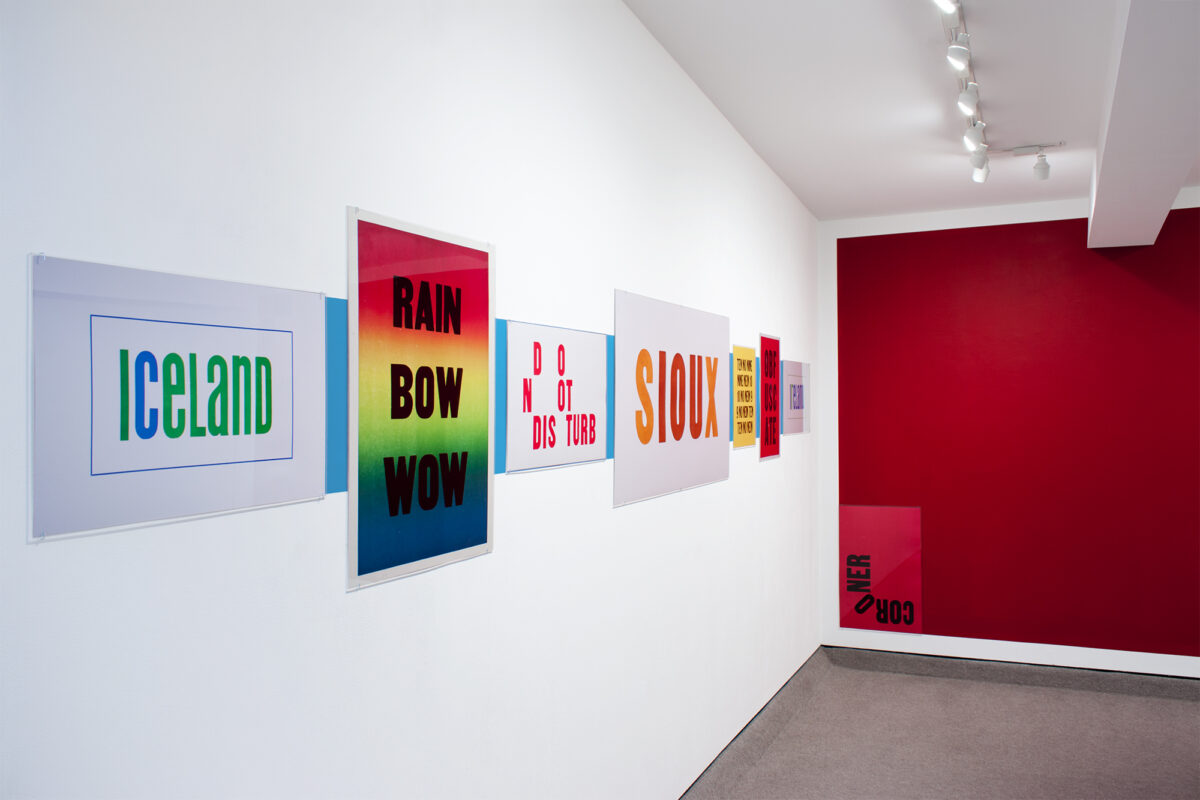
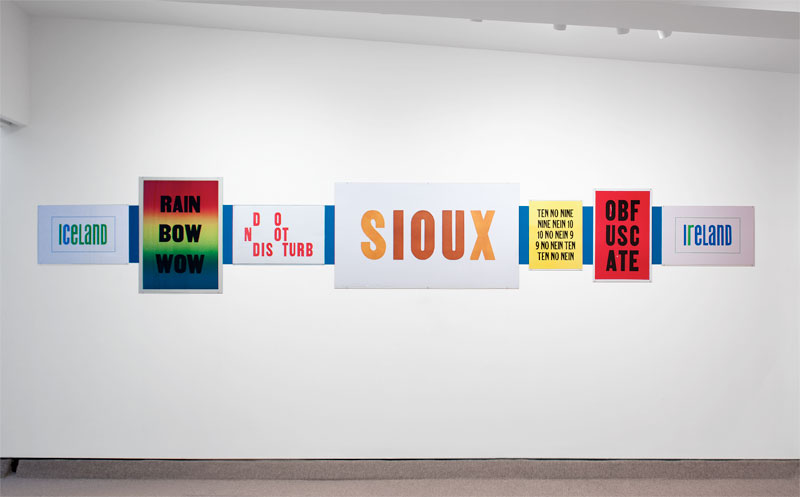
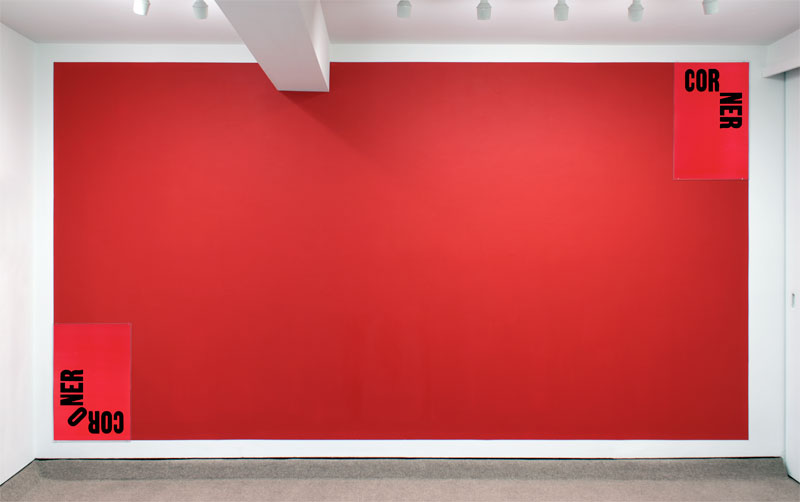
Image/paper size: 25 7/8 x 16 15/16 inches each (65.7 x 43 cm each)
Edition of 10
Signed, numbered and dated on reverse on each sheet
(Inventory #28995)
Image/paper size: 25 7/8 x 16 15/16 inches each (65.7 x 43 cm each)
Edition of 10
Signed, numbered and dated on reverse on each sheet
(Inventory #28995)
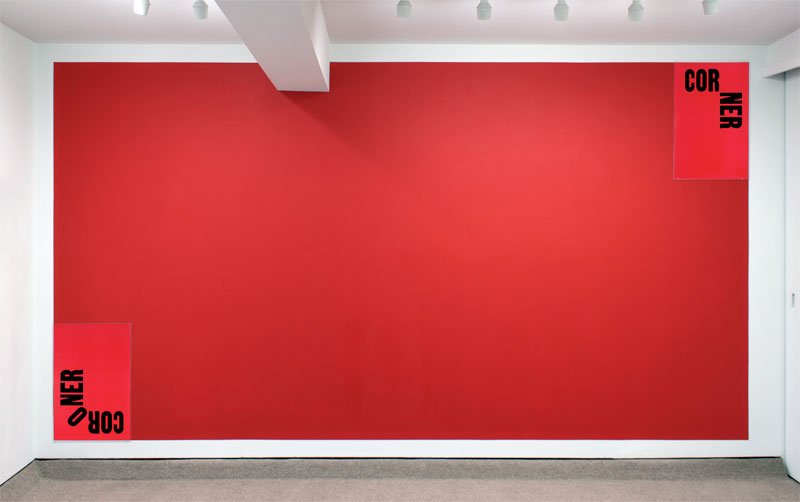
Image/paper size: 25 x 44 inches (63.5 x 111.8 cm)
Edition of 20
Signed, dated and numbered on reverse in graphite
(Inventory #28832)
Image/paper size: 25 x 44 inches (63.5 x 111.8 cm)
Edition of 20
Signed, dated and numbered on reverse in graphite
(Inventory #28832)
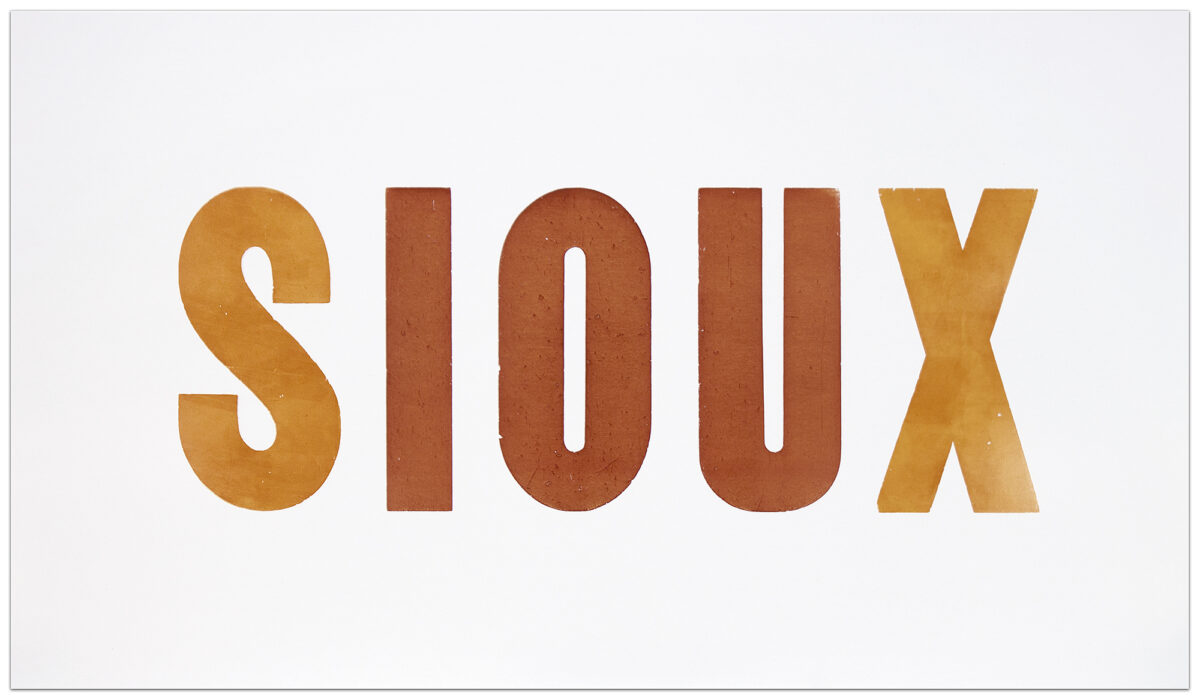
Image size: 26 x 18 inches (66 x 45.7 cm)
Paper size: 27 1/2 x 20 inches (69.9 x 50.8 cm)
Edition of XXV, AP
Signed, dated and numbered on reverse
(Inventory #28774)
Rain Bow Wow, 1991:
BOW is the hinge between RAIN and WOW as it toggles between the two, creating a positive or negative expression: RAINBOW, WOW! or RAIN, BOW WOW.
Image size: 26 x 18 inches (66 x 45.7 cm)
Paper size: 27 1/2 x 20 inches (69.9 x 50.8 cm)
Edition of XXV, AP
Signed, dated and numbered on reverse
(Inventory #28774)
Rain Bow Wow, 1991:
BOW is the hinge between RAIN and WOW as it toggles between the two, creating a positive or negative expression: RAINBOW, WOW! or RAIN, BOW WOW.
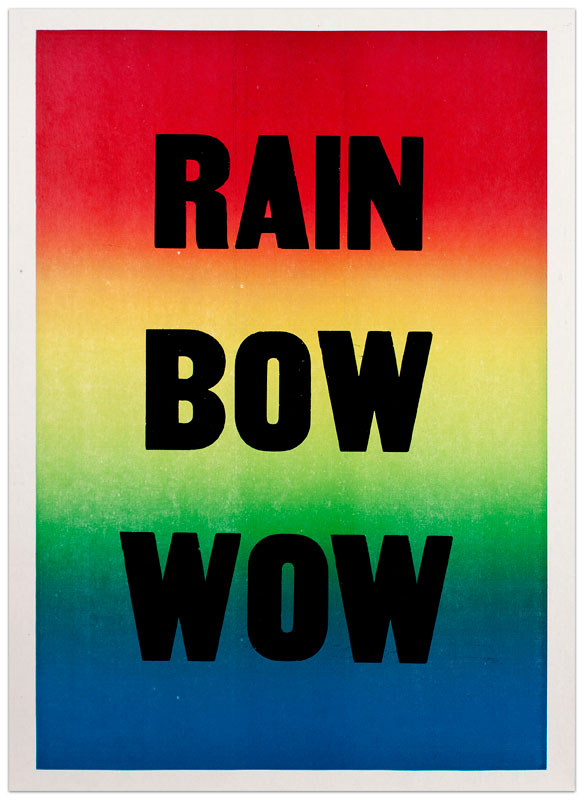
Overall installation measurements vary
Image size: 8 1/2 x 15 1/2 inches each (21.6 x 39.4 cm each)
Paper size: 14 x 22 inches each (35.6 x 55.9 cm each)
Edition of 10
Signed and numbered on both sheet as well as notated ‘Left Sheet’ or ‘Right Sheet’
(Inventory #29067)
Overall installation measurements vary
Image size: 8 1/2 x 15 1/2 inches each (21.6 x 39.4 cm each)
Paper size: 14 x 22 inches each (35.6 x 55.9 cm each)
Edition of 10
Signed and numbered on both sheet as well as notated ‘Left Sheet’ or ‘Right Sheet’
(Inventory #29067)
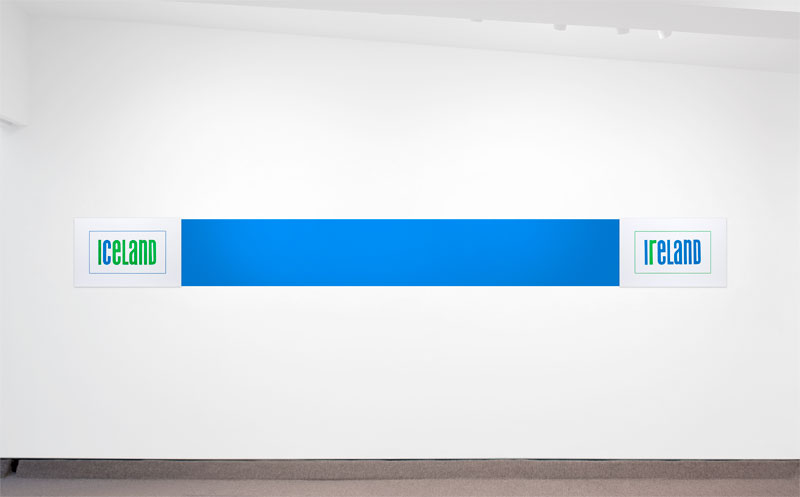
Image size: 21 1/4 x 13 1/4 inches (54 x 33.7 cm)
Paper size: 22 x 14 inches (55.9 x 35.6 cm)
Edition of 50
Signed and dated on reverse, edition numbering not determined
(Inventory #28768)
Obfuscate, 2008:
This work comes from Rosen’s interest in the form text could take and how it could function, to mirror the meaning of that word. The form utilizes the normally verbal strategies involved with obfuscating (evasion, omissions, lies, backtracking, etc.) to foil (linear) reading.
Image size: 21 1/4 x 13 1/4 inches (54 x 33.7 cm)
Paper size: 22 x 14 inches (55.9 x 35.6 cm)
Edition of 50
Signed and dated on reverse, edition numbering not determined
(Inventory #28768)
Obfuscate, 2008:
This work comes from Rosen’s interest in the form text could take and how it could function, to mirror the meaning of that word. The form utilizes the normally verbal strategies involved with obfuscating (evasion, omissions, lies, backtracking, etc.) to foil (linear) reading.
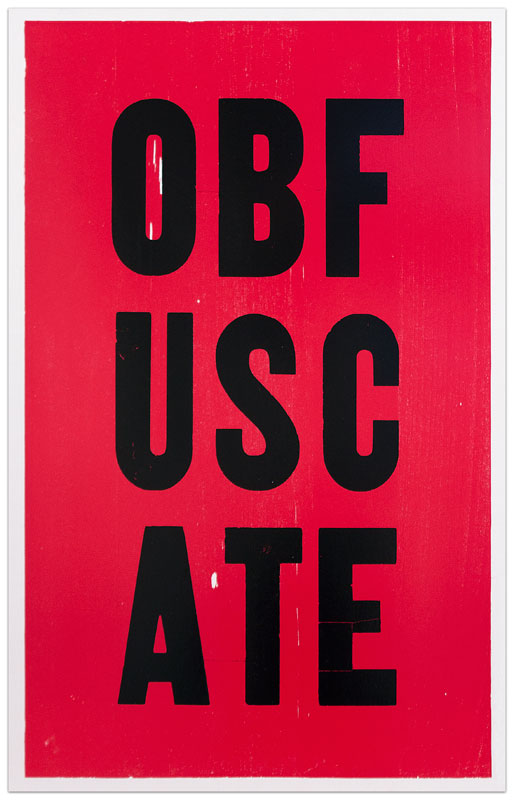
Image/paper size: 14 x 22 inches (35.6 x 55.9 cm)
Edition of 100
Signed and numbered on reverse in graphite
(Inventory #28849)
Image/paper size: 14 x 22 inches (35.6 x 55.9 cm)
Edition of 100
Signed and numbered on reverse in graphite
(Inventory #28849)
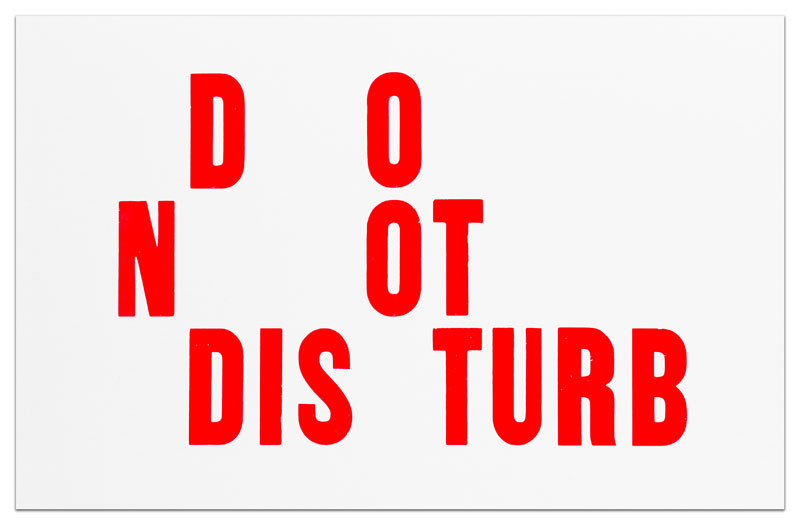
Edition of 120
Signed, dated and numbered on verso
16 1/2 x 12 3/4 inches
(41.9 x 32.4 cm)
(Inventory #28769)
9/10, 1993/2004:
The original idea began in 1993. DU Magazine project,1993 (see text below); wall painting, “Korrespondenzen/ Correspondences,” 1994-5; Goethe Institut Newsletter cover, 1995; stairwell wall painting 18’10″x 10’9″, “Kay Rosen: Lifeli[k]e”; wall painting Dunedin Public Art Gallery “Kay Rosen: Big Talk”, 2004; wall painting “numerica”- palazzo delle papesse centro arte contempoanea, Siena, 2007. The following text accompanied the image in DU Magazine:
Lesson 1 began with the work’s intention of discovering and analyzing new visual and linguistic systems in brief verbal fragments. Because every mark that is made on a page creates meaning, shorter constructions generally provide stricter and more rigorous limits and controls on interpretation than do longer ones. This last lesson offers a very literal scenario on the polemics of size. The dispute concerns quantity– the sum of letters/numbers per line, nine or ten, which is indicated by the final number expressed on that line. For example, N-I-N-E-N-E-I-N-1-0 does indeed contain ten figures. Each line attempts to be specific, clear, and correct in its proceedure and solution, enlisting a variety of strateges, such as reiteration, translation, and enumeration to make its case. But in spite of their insistence, the voice or voices contradict themselves and each other. Their disagreement is a consequence of expression. The subtraction or addition of each unit of meaning, each letter or number, increases or decreases the length of the argument and thus, the conclusion. Lesson 8 is a farcical and elaborate conceit about the behavior of language and its inability to be absolute, certain, and consistent. Moreover, it demonstrates how critical the smallest components are to this behavior.
Edition of 120
Signed, dated and numbered on verso
16 1/2 x 12 3/4 inches
(41.9 x 32.4 cm)
(Inventory #28769)
9/10, 1993/2004:
The original idea began in 1993. DU Magazine project,1993 (see text below); wall painting, “Korrespondenzen/ Correspondences,” 1994-5; Goethe Institut Newsletter cover, 1995; stairwell wall painting 18’10″x 10’9″, “Kay Rosen: Lifeli[k]e”; wall painting Dunedin Public Art Gallery “Kay Rosen: Big Talk”, 2004; wall painting “numerica”- palazzo delle papesse centro arte contempoanea, Siena, 2007. The following text accompanied the image in DU Magazine:
Lesson 1 began with the work’s intention of discovering and analyzing new visual and linguistic systems in brief verbal fragments. Because every mark that is made on a page creates meaning, shorter constructions generally provide stricter and more rigorous limits and controls on interpretation than do longer ones. This last lesson offers a very literal scenario on the polemics of size. The dispute concerns quantity– the sum of letters/numbers per line, nine or ten, which is indicated by the final number expressed on that line. For example, N-I-N-E-N-E-I-N-1-0 does indeed contain ten figures. Each line attempts to be specific, clear, and correct in its proceedure and solution, enlisting a variety of strateges, such as reiteration, translation, and enumeration to make its case. But in spite of their insistence, the voice or voices contradict themselves and each other. Their disagreement is a consequence of expression. The subtraction or addition of each unit of meaning, each letter or number, increases or decreases the length of the argument and thus, the conclusion. Lesson 8 is a farcical and elaborate conceit about the behavior of language and its inability to be absolute, certain, and consistent. Moreover, it demonstrates how critical the smallest components are to this behavior.
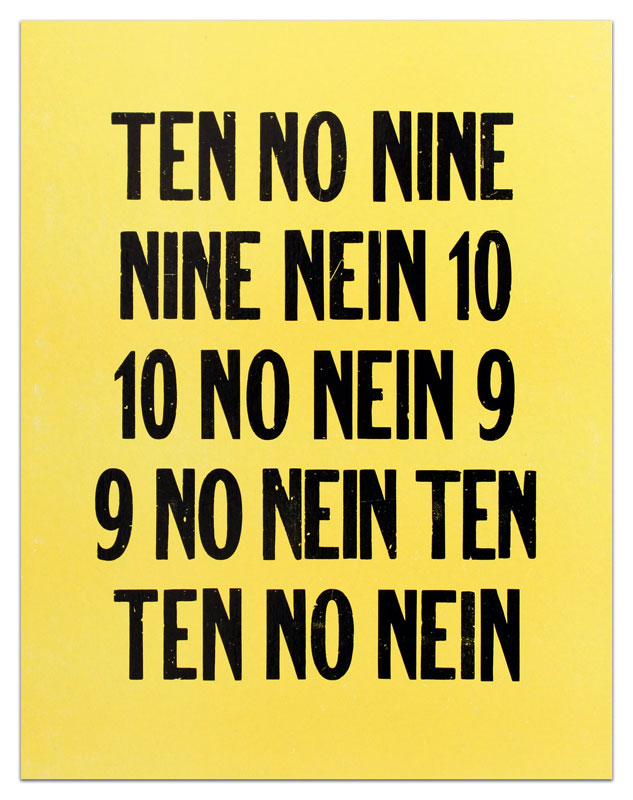
Image/paper size: 22 x 14 inches each (55.9 x 35.6 cm each)
Signed and dated on reverse on sheet 1/2
(Inventory #28773)
Image/paper size: 22 x 14 inches each (55.9 x 35.6 cm each)
Signed and dated on reverse on sheet 1/2
(Inventory #28773)
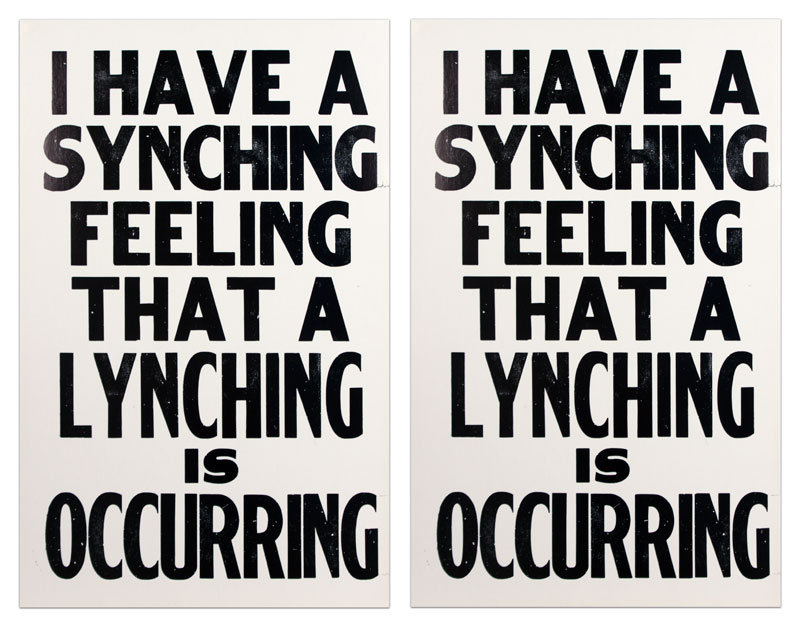
No results found.